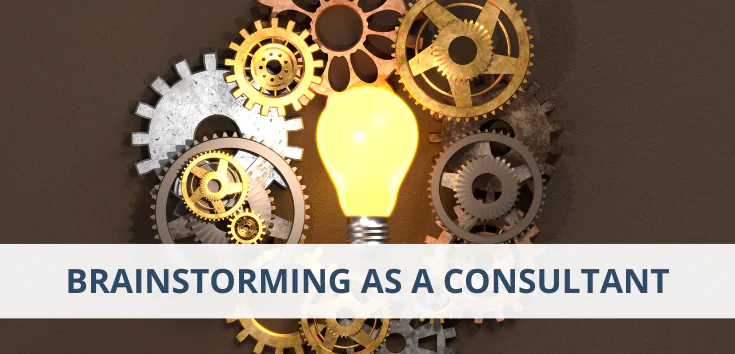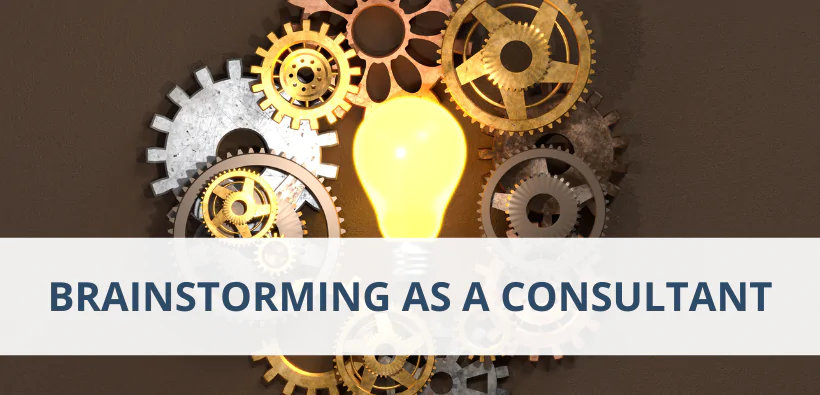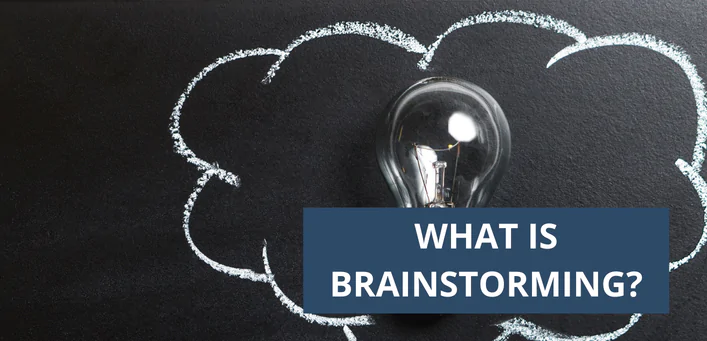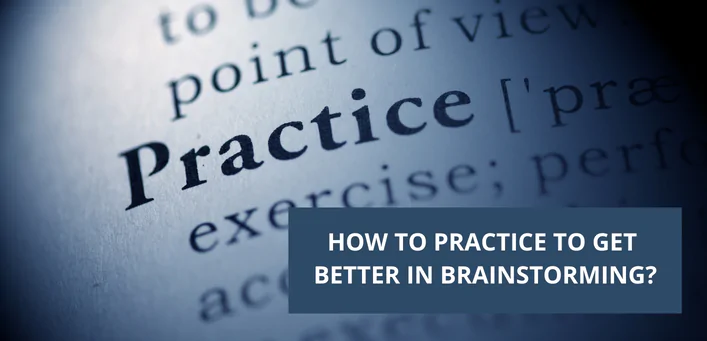Brainstorming is one of the most misunderstood parts of the consulting interview and among the most challenging aspects of the job for fresh consultants. This article of our expert Cristian aims to give an overview on what brainstorming actually is, how experienced consultants use it in their day-to-day life, and how to best prepare for the brainstorming part of management consulting interviews. The article is structured along a set of questions, reflecting the most common concerns that have been addressed to the expert by former and present mentees.


Brainstorming as a Consultant


A structured set of ideas that are responding directly to the question asked, have a clear hypothesis behind them and are ideally prescriptive (i.e., they are giving the client an indication of what they should actually do).
Brainstorming does not mean responding with a long string of random ideas, one second after the interviewer or client asked their question. Instead, it is a structured answer that aims to be insightful and provide value to the conversation.
In many ways, framework questions (usually at the beginning of the case) and brainstorming questions (usually in the middle of the case) resemble each other because they are both structuring questions. The main difference is that while the former is investigative, aiming to provide the back-bone of core questions that will guide the analysis throughout the case, the latter is prescriptive, aiming to offer ideas of what the client should do. In practice, when a candidate answers a framework question, typically the bullet points in the structure are questions themselves, whereas in a brainstorming question, the bullet points are ideas or statements.


Let’s assume you are a consultant participating in a client discussion that is relevant for your particular work stream. The client suggests you dig deeper into what could be some of the features that would improve customer experience. The meeting finishes and your manager suggests you take the lead on this new topic. What happens next?
- You create the first draft. Usually, that means literally sitting down and doing your best at coming up with ideas and structuring them in a way that is easy to communicate. Depending on the topic and your level of experience, at this point you might want to do some independent research online or on the firm’s internal knowledge platform.
- You seek feedback within the team. Once the first version is finished, you start asking for feedback within the operation team, meaning your manager or colleagues who might have experience with this topic but are currently on different work streams.
- You seek senior feedback from inside and outside the team. Once you’ve integrated the feedback from the team, you can reach out to internal and external experts on the topic to give you an additional perspective, as well as the Partners and Senior Partners serving this particular client. They will help you polish both the content and the messaging of your answer.
- You seek feedback from the client. By the time you get to this point, you will have a refined version of your initial draft, that benefitted from the input of your entire team and is aligned with all the stakeholders on your side. The next step is to seek alignment and input from the client. This means discussing the outcome of the brainstorming with a few clients of varying seniority and asking for their input.
- You present to the client. Once you’ve integrated the feedback from all parties, you can then share it with the client, knowing that not only is the solution the best that your team could come up with, but that some of the clients in the room have participated in defining the solution.
In the interview, however, answering to a brainstorming question is a much simpler affair. Basically, the candidate needs to focus only on the first step that a consultant would go through, i.e., coming up with ideas and structuring them – the minimum viable product.


Typically, it consists of the interviewer asking a question and the candidate immediately starting to shoot answers in no particular order or structure, taking breaks once in a while when they run out of ideas. There is no structure, no depth, few to none insightful or creative ideas, and little confidence in communication. Needless to say, it’s not recommended to do this. ‘Shooting from the hip’ is what Partners do in senior meetings after they had at least ten years of experience in a particular industry. It’s not something to be attempted by an aspiring consultant during an interview.


To begin with, that requires clarifying what the interviewer is looking for in the candidate. In short, they are trying to assess the following:
- Is the candidate taking time to consider the question and prepare their answer?
- Is the answer provided by the candidate structured?
- Does the candidate show creativity and rightfulness with their solution?
- Are they demonstrating an understanding of the industry and client situation in line with their background?
- Is the candidate using as much as possible of the data points already presented in the case (i.e., connecting the dots between different parts of the case)?
- Are they presenting the ideas in a convincing way, showing confidence and building rapport with the interviewer?
- Do they have a hypothesis (or multiple) behind their answer, and are they providing practical ideas that are feasible for the client to implement?
So, what you need to do as the candidate is the following:
- Make sure you understand the question. If you’re not sure, then play it back to the interviewer in your own words and get their confirmation that you are looking at the right thing.
- Politely ask for time. There’s no set time. Speed is only one of the areas you are assessed for, and by far not the most important one. 30 seconds to 1 minute is ok. Anything beyond that is rather too much for a brainstorming question in the middle of a case. So rather try to focus on taking the minimum amount of time you need to come up with a structure that is broad, deep and creative.
- Come up with a list of ideas. Try to connect all the elements of the case and squeeze as much out of the data about the client and the project that were provided to you in the prompt.
- Find common elements among these ideas – this bottom-up approach to structuring is more likely to be leading to original structures rather than overusing the same ‘buckets’ everybody else is.
- Create a MECE (Mutually Exclusive, Collectively Exhaustive) structure from your ideas.
- Present the areas of your structure top-down before going into detail in each of them.
- If the interviewer gives you feedback, find ways of integrating their ideas and building on them (the interview is at its core a conversation).


The content of the ideas is what candidates most often struggle with. Realistically speaking, the volume and quality of the ideas you are likely to come up with depends significantly on your experience and knowledge of the industry. However, this can be improved with time through practice.
One tip you can use is to try and approach the brainstorming process both bottom up and top down (bottom-up was explained above). Top-down would mean thinking of what could be some of the relevant areas you could structure the answer in, then thinking deeper of what other ideas could fall within them. For instance, if you are asked about ideas to improve profitability, one easy top-down structure would be to look at ways to increase revenue and ways to reduce cost. So you’d want to dive deeper into each of these and try to think of additional points.
However, don’t be too stressed about it. Unless you’re applying for an expert role, there are no expectations that your ideas should be mind-blowing. What matters more is showing that you have at least a basic business sense and the ability to think through a problem in a structured way, connecting the client’s pain points with a potential solution and communicating this in a clear, effective way.


There are different schools of thinking. Some claim it is better to come up with the areas and then just generate ideas. From my experience as both a senior consultant and a coach, I’ve come to believe the opposite – that you should think of the ideas first, in a list format, then bucket them. The reason is that this approach will both lead to more creative buckets than the overused ones all interviewers are bored with, and it will also ensure that you are thinking outside the box. Plus, unless you have a lot of experience in that particular field of the case or the structure is an obvious one (like profitability being divided in revenue and cost), then you cannot know what the best buckets are anyway.


- Practice without a timer. Instead of trying to be fast, try to work on generating your best possible answer. Take five, ten, fifteen minutes if you have to, until you feel you have created the best possible structure you can come up with. Then check with the answer in the case book and figure out what ideas you missed on. This way, you will not only develop a strong sense of what a good answer feels like, but also build organically on your industry knowledge.
- Use shorthand when note-taking. Don’t write full sentences (only keywords) and instead try to develop the ideas more as you speak. With practice, you will get increasingly good at this.
- Practice brainstorming questions in batches. Not only will this have an effect similar to that of training a muscle in an isolated way, but you will also start getting a stronger sense of the contrast between different types of brainstorming questions. Gradually, you will also develop a sense of what good answers feel like, what is their depth and breadth, and how insightful they are.
- If you really want to go the extra mile, you can start building a log of typical answers to brainstorming questions. Again, if for instance you are thinking about ways to increase revenue, you are always going to be suggesting ways of either increasing quantity or price, so you can develop with time a menu of levers (e.g., product bundling). This sort of menus exists even for actual consultants when they embark on a new project. The responsibility of the consultant - and of the candidate in the interview - is to figure out how to best tailor these responses to the specific question that was asked and that particular client context.
Hopefully this provides you with a starting point towards improving your approach to brainstorming questions. The most important point is to approach interview preparation with the confidence that with practice you are going to get better and getter. I know you will! Feel free to reach out with individual questions to Coach Cristian.
8. About the Author
 Cristian
Cristian
#1 rated and most recommended McKinsey Coach | 97% success rate
- Languages: English
- Location: Germany
After graduating from Oxford, Cristian gained several years of experience at McKinsey. Until today, he was working in eight different countries and nine different industries and founded his own consultancy, Writer & Entrepreneur.
With his 5-star rating, the expert has the highest recommendation rate of the coaches. None of his candidates failed their case interview after 4 coaching sessions with Cristian.
Continue to Learn








